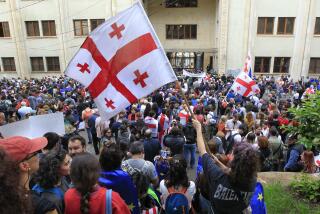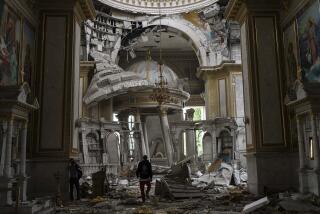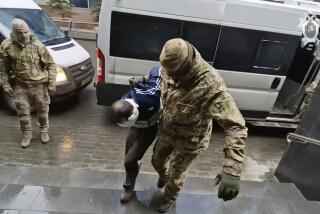Russian claims appear inflated
TSKHINVALI, GEORGIA — A visit to this war-strafed city Sunday turned up no proof of Russian claims that more than 2,000 people died here. Nor were there any ready signs of what Prime Minister Vladimir Putin referred to as “genocide.”
The downtown of Tskhinvali, the capital of Georgia’s breakaway republic of South Ossetia, sustained heavy damage in a five-day barrage of rockets and missiles as Russian troops and their local allies battled Georgian forces, and dozens of deaths have been documented. There is still no running water in the city, and residents are tremulous and shellshocked.
Tskhinvali Regional Hospital had confirmed the deaths of 40 people as of Sunday, though the number was expected to grow, said Tina Zakharova, an Ossetian doctor who showed The Times a log of deaths. That figure included both civilians and combatants: people who died at the hospital, whose bodies were brought to the hospital or whose families reported burying their dead in villages.
It has been more than a week since Georgia launched a military operation in South Ossetia, to bring the pro-Russian rebel region under the control of the central government. Instead, Georgian soldiers met a humiliating defeat in an overwhelming Russian counterattack.
South Ossetian authorities are still laboring to figure out how many people died in the battles for the capital, Zakharova said. The task was complicated because some families simply buried their dead in their yards, unable to bring the corpses to the hospital to be registered. “There will be more,” she said.
Russian officials have claimed that the city was flattened, comparing the wreckage to the Battle of Stalingrad during World War II. Leaders in Moscow have repeatedly used the term genocide, and spoke of thousands of corpses.
Burned-out tanks remain scattered on the streets of Tskhinvali, but the city’s roads and bridges remain basically unscathed. Many buildings had windows shattered and roofs destroyed; some appear to have caught fire and burned to charred shells. The streets around the government center seem to have borne the brunt of the fighting, but few walls appear to have fallen in the assault.
“You can’t explain how it felt. It was horrible,” said Soslan Borisovich, a vice colonel with the breakaway republic’s militia, who fought alongside Russian troops and manned a checkpoint at the southern edge of Tskhinvali. “For two days, the ground was shaking nonstop.”
Many Ossetians spoke with anger about the Georgian troops who had battled their way into Tskhinvali, only to be driven back by the Russians.
“They were the closest to us before the war, and now they are the most frightening enemy,” said Evelina Kulumbekova, 49, who holed up in the basement of her apartment building during the fighting. “It feels like your own brother has cut off your head.”
The question of how many people died here is significant in part because Moscow has used the shocking death toll to justify its overwhelming military response. Russia sent troops pouring over the border, unleashed airstrikes and seized control of wide chunks of Georgia outside South Ossetia and another breakaway republic, Abkhazia, shutting down the country’s main road and severing transportation links between the capital and the Black Sea coast.
The Kremlin has come out heavily in support of independence for Georgia’s breakaway republics, a move that would redraw the borders of the post-Soviet Caucasus region. Critics accuse Russia of trying to engineer a de facto annexation of the neighboring lands, a charge Moscow firmly denies.
Russia’s relationship with the West has abruptly soured with the military incursion. The Bush administration was infuriated, and post-Soviet politics were reshaped by a new understanding of the threat Russia may pose to its Western-leaning neighbors.
Russian leaders say the campaign was necessary to protect the people of South Ossetia, who feel historical kinship with Russia stretching back to czarist times. South Ossetians rebelled against Georgian rule shortly after the collapse of the Soviet Union in 1991, and have been largely autonomous since then.
“After what happened, it should be clear that they should have self-determination,” Konstantin Zatulin, the first deputy chairman of the Russian State Duma’s committee for the Commonwealth of Independent States said on Sunday. “The reality is that for 15 years, at least, South Ossetia and Abkhazia have been independent, in fact.”
Seated in a conference room in the main government building of South Ossetia, Zatulin said he was in charge of a $100-million Russian initiative to rebuild a section of Tskhinvali. The project, he said, would create a “Moscow zone” in the city.
“Russia is not annexing. Russia is not invading,” he said. “It’s not true. The goal of Russia is peace in the Caucasus.”
Zakharova, the doctor, spent the days of heavy fighting in the rancid basement of the hospital, where staff members set up metal cots and thin mattresses and treated patients under the glow of bare lightbulbs. She insisted that visitors climb down to see the basement, where cobwebs clot the ceiling and the air is thick with the stench of human waste and blood.
“The world should know,” she said firmly. “This should not happen again.”
Recalling the arrival of Russian troops, her blue eyes flooded with tears. “They were our saviors,” she said.
By Sunday, Ossetians were out in the streets, tidying up and swapping stories of their ordeals as refugees or cowering in bomb shelters. Wreckage was piled along the sides of the roads in the town’s leafy center, and talk was beginning to turn to the future.
It is unclear what will come next for South Ossetia. Russia has pledged to back the province’s drive for independence from Georgia. Many people here say they already count themselves as Russians; most hold Russian passports, the Russian ruble is the going currency, and the elderly receive pensions from Russia.
Across town, South Ossetian spokeswoman Irina Gagloyeva sat with other officials in the yard of the government building. Ossetian militiamen milled around in ragtag camouflage, with knotted bandannas and half-grown beards. Ordinary life was beginning to stir on the streets -- girls in flowered dresses wandered past, and clusters of old men gathered.
“You see what the Georgians have done here,” Gagloyeva said. “They see Georgians as murderers.”
South of town, past the checkpoint where Ossetian militiamen sprawled on a junked bed, the silent country road ran back into Georgia proper. All along the way, Russian soldiers had dug in. They hauled tree branches and cinder blocks into the road to erect checkpoints, and pitched their tents in encampments.
The Russian soldiers were practically the only glimmer of life in a war-drained landscape.
The stench of death hung in the nearly deserted villages around Tskhinvali. At least two corpses were sprawled on the main road, swelling in the summer heat. A few old women wobbled along in flapping dresses and head scarves. Every once in a while, a skinny Georgian man would appear on the roadside, trying to hitch a ride south to join his countrymen.
--
More to Read
Sign up for Essential California
The most important California stories and recommendations in your inbox every morning.
You may occasionally receive promotional content from the Los Angeles Times.










